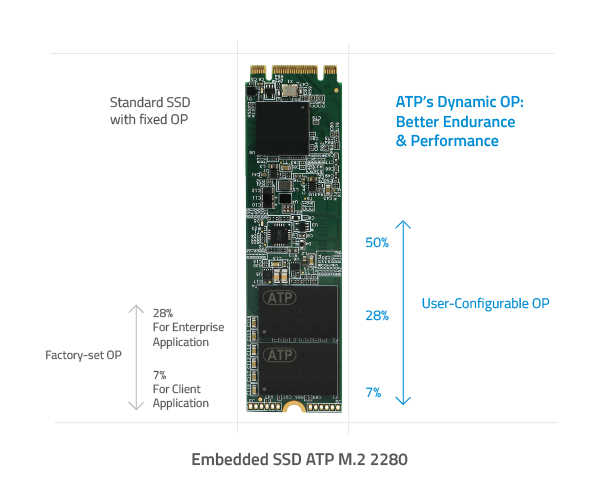
Determining the right configurations that will address various workloads is essential to the operational health of an enterprise storage drive. Often, manufacturers make pre-set configurations that do not have the flexibility to be altered according to actual needs, resulting in compromised performance and higher costs down the road.
The ATP Dynamic Over-Provisioning (OP) solution breaks the mold by giving users the freedom and flexibility to configure SSDs according to the actual workloads of specific applications. Through ATP's simple software, users can freely and easily set the OP percentage from 7% to 14%, 28%, 50% and above to better suit their requirements.
Over-Provisioning Basics
When solid state drives (SSDs) ship out, they usually come with a fixed reserved free space that is not visible to and cannot be used by the user. Over-provisioned space is the storage capacity of a drive specifically retained for controller features like garbage collection and trim. Manufacturers typically set OP space at 7% for client applications, or 28% for enterprise storage applications.
Traditional hard disk drives (HDDs) and SSDs write and erase data differently. When an entry is deleted from an HDD, it does not actually disappear. The sector that data occupies does not get freed up. Instead, only when new data physically overwrites the old data will it become truly gone.
SSDs, on the other hand, read and write data on "pages." Pages are stacked to one another on a block. While data may be read and written at page level, data may only be erased at block level. Data cannot be overwritten. For a block to be freed up and new data to be written on it, data on all pages in that block must be erased at one time.
To clear out invalid data, SSDs employ two important processes called garbage collection and trim. Garbage collection is the moving of valid data to other blocks so the original block can be erased for use. Trim allows a host to inform the SSD which blocks of data are no longer in use and may be utilized by new data. The constant relocating, rewriting, and erasing contribute to the SSD's higher workload and ultimately, its degradation.
Measuring SSD Performance and Endurance
Write amplification index (WAI) is the ratio of the total gigabytes written by the host to the NAND. As discussed above, SSD blocks must be erased first before they can be written to. For write-intensive operations, more extra writes are needed, thus causing data written on the SSD to be greater than what the host had intended to write. Consequently, the greater workload causes performance to suffer.
Terabytes written (TBW) is another way to gauge SSD endurance and performance. TBW refers to the total amount of data that can be written onto a storage device before it is bound to fail. A higher TBW means longer SSD usage life.
The Optimization Challenge
Embedded applications require a varied range of tasks. Write-intensive applications, for example, naturally increase WAI. In order to decrease WAI and increase the life span of the SSD with higher TBW, a higher OP (less usable storage) should be implemented to ensure stability, improve performance and extend the SSD usage.
Read-intensive applications, on the other hand, require less endurance so high WAI and SSD degradation are not much of a concern, thus a lower OP (higher usable storage) may be implemented.
Most SSDs in the market come with a fixed OP percentage, giving no flexibility for users to evaluate workloads and optimally configure SSDs for the best-possible performance and endurance.
Benefits of the ATP Dynamic Over-Provisioning Solution
The ATP Dynamic Over-Provisioning solution ATP gives users the freedom and flexibility to configure SSDs according to the actual workloads of specific applications.
Performance Optimization
Engineers at ATP conducted thorough testing to determine how different OP percentages can affect SSD performance and endurance, and have found that applications with write-intensive workloads can greatly benefit from high OP percentage.
- Random write performance. A low 7% OP may show around 90% drop in 4K random write speed after prolonged testing. Setting a higher OP percentage may lead to better, more consistent performance compared with a lower OP percentage.
- Write amplification index (WAI). OP percentage is inversely proportional to WAI — a higher OP percentage helps reduce WAI and improves performance.
- Terabytes written (TBW). OP percentage is directly proportional to TWB — a higher OP percentage demonstrates better endurance.
Cost Optimization
At the outset, it would appear that SSDs with lower OP percentage mean lower cost, as it provides more capacity for users. In reality however, the higher cost will be felt in the long term. A lower OP percentage, although offering more capacity, leads to faster SSD degradation and more frequent drive replacements. High OP settings are for users who are willing to trade off capacity for extra performance and endurance.
Flexibility
By enabling users to configure the OP setting based on actual needs, the ATP Dynamic Over-Provisioning solution maximizes the performance and life span of the SSD, translating to greater productivity and savings in the long term. For more information, visit the ATP website or contact an ATP Distributor/Representative in your area.